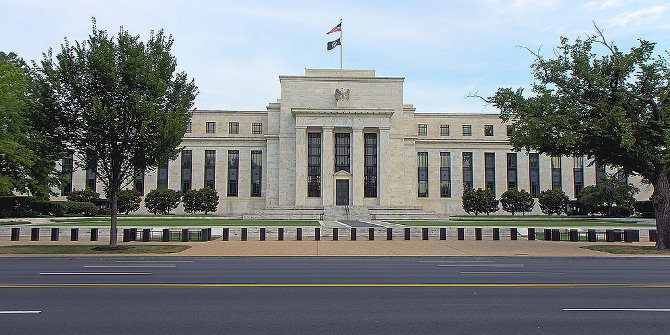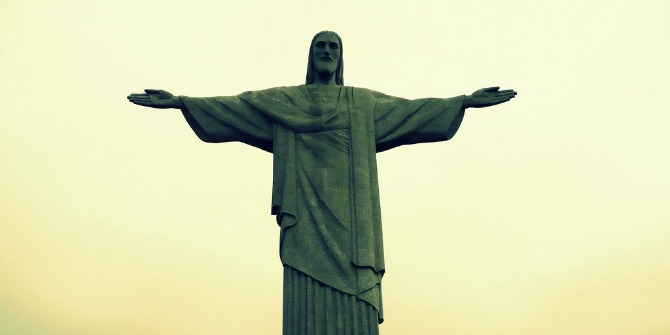 Through the twentieth century, Los Angeles caught the eye of many an urban scholar, resulting in a series of seminal books which examined the city and its relationship to those who live within it. In Street Level, Rob Sullivan aims to provide a review of this literature whilst also giving readers a clear account of L.A. as it exists today. Sullivan finds space for fascinating stories of legal crusading and anecdotes about architectural travesties which entertain and inform, but overall Ben Mueller is dissatisfied with the author’s approach.
Through the twentieth century, Los Angeles caught the eye of many an urban scholar, resulting in a series of seminal books which examined the city and its relationship to those who live within it. In Street Level, Rob Sullivan aims to provide a review of this literature whilst also giving readers a clear account of L.A. as it exists today. Sullivan finds space for fascinating stories of legal crusading and anecdotes about architectural travesties which entertain and inform, but overall Ben Mueller is dissatisfied with the author’s approach.
 Street Level: Los Angeles in the Twenty-First Century. Rob Sullivan. Ashgate. January 2014.
Street Level: Los Angeles in the Twenty-First Century. Rob Sullivan. Ashgate. January 2014.
Los Angeles: that ubiquitous metropolis, manufacturer of entertainment dreams, crucible for 16 million human souls (and 5 million cars). It is surely uncontroversial to assert that most people outside of LA have a rather one-sided exposure to the city: consuming the masses of output generated by the entertainment industry and picking up (consciously or not) fashion and lifestyle fads from LA’s more prominent denizens. It is equally uncontroversial to assert that a metropolitan area with 16 million inhabitants, home to the fifth-busiest port in the world and Western USA’s largest manufacturing centre, whose economy, were Greater Los Angeles an independent country, would be the 16th-largest in the world (roughly on par with Indonesia), is bound to have more going for it than a vibrant beach culture, Botox parties, and a frankly underwhelming Boulevard whose pavement features names of people who are good at entertaining the rest of us.
Rob Sullivan’s book Street Level: Los Angeles in the 21st Century makes a solid effort to offer plenty of interesting reading material, providing a more balanced depiction of an iconic city, clarifying its historical trajectory and presenting a more widely-cast cross-section of the metropolis. The book is ultimately a work of geography, so there are plenty of references throughout to urbanism, spatial characteristics, city design, tracing of LA’s links to the global economy, and so forth. But Sullivan, a lecturer at UCLA, is not your conventional geographer. He packs the book with facts, stories and anecdotes, all of them meticulously sourced and unfailingly engaging. Best to illustrate the point with a random selection of anecdotes: LAPD officers choked to death 15 suspects between 1975 and 1982 (NYPD managed only one in the same period); Greek-American real estate Aris Agnagos is a key player in Los Angeles’ left-wing political scene and once bailed out the Sandinista government with a one-million dollar emergency loan; and in 1935, during the depths of the Great Depression, the LAPD attempted to set up a ‘bum blockade’ on the city’s borders to turn away Dust Bowl refugees. The list above provides a taster of the kinds of gems buried in the book.
The opening chapter is a highly readable account of the stylistic genesis of the wondrous kitchen sink of architectural design that is Greater Los Angeles; a compelling pastiche of sources that tells the story of how LA was built from the perspective of those who did the building. This account of rapid industrialisation, of what was effectively a blank canvas in 1900 turning into a world city within a few decades, may not necessarily excel in terms of comprehensiveness and narrative structure, but is an enlightening read. Sullivan’s chronicle makes meaningful the bewildering aesthetic stew in the city, explaining its development as a combination of capitalist productivity, an immigrant culture, and the lifestyle and cultural ambitions of the Southern Californian. In this “crazy quilt oddball display of architectural icons and architectural travesties,” he concludes, “it does not really matter whether LA boasts an honorific title for its (possible) status as the capital of the finest domestic architecture in the United States or a horrific reputation for its lack of architectural cohesion.” It is one of Sullivan’s opening declarations that “LA being LA – and therefore vast, polycentric to the point of formlessness, magnificently awful as well as hypertrophically beautiful, dismal as well as stunning, dreary as well as fabulous, persistently woeful as well as preternaturally wondrous – may resist any final definition more sedulously than any other city on earth.” In view of the dazzling collection of stories and facts that follows, it is difficult to disagree with his assessment.

The accumulation of factoids that Sullivan has assembled is impressive, especially because he takes great care to embellish such tales with context, ensuring that a complete picture is provided. In this regard, the chapter ‘Real L.A.’ is the most informative one. In it Sullivan portrays, among other things, Los Angeles’ long history of successful labour activism, and its tradition of radical lawyering. In 1923, for instance, police incarcerated 600 striking longshoremen, beginning to make arrests after the strike leaders began reciting the Constitution and Declaration of Independence. When lawyers served writs of habeas corpus the strikers were freed within days. It was a legal victory that demonstrated that a) the incriminating texts the strikers were reading had real meaning for the lives of the destitute, b) America’s constitutional values were always aspirational, and had (have) to be implemented by passionate adherents facing piggish old-world reactionaries determined to fluster the progression of liberal ideals for either selfish or commercial reasons. This puts into perspective the entire American journey, including the long arduous struggle for civil rights. To illustrate the point: the longshoremen strike produced the counteraction of increased vigilante violence against workers, especially migrant workers. But that in turn solidified LA’s emerging culture of legal activism. Sullivan finds space for fascinating stories of legal crusading, painting a picture of an operose but increasingly successful effort to make LA (and the USA) a more liveable place for all. In a nice touch, he ties this story together by showing how legal activism continues into the present era. This depiction of the birth and growth of a widespread civic consciousness corrects the image of LA as nothing more than the capital of blockbusters and plastic surgery. And because it is all spiced with examples of the lives of ‘everyday’ residents, and structured around the economic history of the region, it never becomes one-sided.
What can and should be taken issue with, however, is that for the majority of the book – not all chapters, but most – Sullivan crafts his text in opposition to particular authors’ analyses of LA. The targets of his objections are systematically dismantled and ridiculed, mocked even. Yes, it is true that Bernard Henry-Levy’s charge that LA is not a city because a city “must have a vantage point, or several, from which it can, as in the Paris of Hugo’s Hunchback of Notre Dame, be embraced with a single glance” is ridiculous and, if anything, indicative of Levy’s patronising obscurantist snobbery (especially in light of the fact that the Hollywood Observatory provides spectacular views of LA). But is it a good use of Sullivan’s and the reader’s time to spend ten pages refuting the absurd charge? Whole sections of the book exist for Sullivan to take on obscure existentialist or post-modernist critiques of LA penned by various auteurs from niche paradigms. These chapters read a bit like those of a graduate dissertation where one dismantles opposing arguments to underline the fecundity of one’s own intellectual output. The chapter on culture with which Sullivan concludes the book is a fiery rejection of those who denounce iconic LA movements like hip-hop and its car culture. Fine – but few of his readers probably buy into such narrow-minded ivory tower critiques in the first instance. Much more interesting would have been a historical account of these movements, interspersed with more of the anecdotes that Sullivan is so gifted at unearthing. The complaint here is that Sullivan spends valuable time and space negating the output of others, when he should focus on the kind of positive (Californian?), engaging, and vibrant narratives like those in Chapters 1 and 5.
Unfortunately, this is not just a minor quibble, but an underlying flaw with the book. For those wishing to learn more about one of the world’s great cities, Street Level is a commendable read: much is to be learnt from this book. But the reader should be aware that he or she will regularly encounter needlessly long and relatively lacklustre passages that are unlikely to be of interest to anyone but specialists on the particular school of thought Sullivan is discrediting. Such passages detract from the overall enjoyability of the read – but that is a reason to skim them, rather than to forgo the book entirely.
This review originally appeared at the LSE Review of Books.
Please read our comments policy before commenting.
Note: This article gives the views of the authors, and not the position of USApp– American Politics and Policy, nor of the London School of Economics.
Shortened URL for this post: http://bit.ly/1oobbOo
——————————————–
 Ben Mueller –
Ben Mueller –
Ben Mueller is the International Relations Stonex PhD Scholar at LSE IDEAS. His research focuses on systemic change in international politics. Ben studied PPE at Oxford and then took an MSc at LSE. Prior to his PhD studies he was a Visiting Associate at Boston Consulting Group. Read more reviews by Ben.






